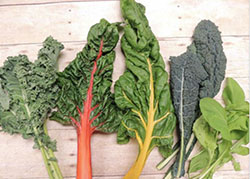Add Leafy Greens to Your Menu
Mary Ellen Fleming, Family & Consumer Science Extension Agent, San Luis Valley Area

Greens are an excellent food you can eat regularly to help improve your health. Leafy green vegetables are low in calories and packed with fiber along with vitamins and minerals. Fiber is an important component of our diet, but most people eat too little. This is, in part, due to higher consumption of convenience and refined foods in our food supply, which are most often low in fiber. Additionally, Americans are not eating as many vegetables per day as dietary experts recommend.
Try greens, you just might like them! To encourage you or your family to eat more green leafy vegetables, learn more about and choose from the variety of greens listed here:
- Kale: This dark leafy green is an excellent source of vitamins A, C, and K, has a good amount of calcium for a vegetable, and also supplies folate and potassium. Kale’s ruffle-edged leaves may range in color from cream to purple to black depending on the variety.
- Collards: Used in Southern-style cooking, collard greens are similar in nutrition to kale. They have a heartier and chewier texture and a stronger cabbage-like taste. They are popular with the raw food movement because the wide leaves are used as a wrapper instead of tortillas or bread. Try wrapping your sandwich in greens instead of using bread!
- Turnip Greens: If you buy turnips with the tops on, you get two vegetables in one. Turnip leaves are another Southern favorite. More tender than other greens and needing less cooking, this sharp-flavored leaf is low in calories yet loaded with vitamins A, C, and K as well as calcium.
- Swiss chard: With red stems, stalks, and veins on its leaves, Swiss chard has a beet-like taste and soft texture that’s perfect for sautéing. Chard contains 15 calories in ½ cup and is a good source of vitamins A and C, potassium, and iron. Try sautéing for a side dish.
- Spinach: This wonderful leafy vegetable is widely used and provides a great source of niacin, zinc, and iron. Get your daily greens with tasty spinach by incorporating it into a salad, omelet, or fresh smoothie.
- Mustard greens: Another Southern green with a similar nutrition profile to turnip leaves and collards, mustard greens have scalloped edges and come in red and green varieties. They have a peppery taste and give off a mustardy smell during cooking. Their spiciness can be toned down by adding an acid, such as vinegar or lemon juice toward the end of cooking.
- Red and Green Leaf and Romaine Lettuce: A familiar sight in salad bowls; these lettuces are high in vitamin A and offer some folate. Leaf lettuces have a softer texture than romaine, a crunchy variety used in Caesar salads. Fans of Iceberg lettuce may go for romaine, a crispy green that’s better for you (the darker the lettuce leaf, the more nutrition it has).
- Cabbage: Although paler in color than other leafy greens, this vegetable is a great source of cancer-fighting compounds and vitamin C. Available in red and green varieties, cabbage can be cooked, added raw to salads or stir fries, shredded into a slaw, or made into sauerkraut.
The above list of greens and their attributes was adapted from: http://www.webmd.com/diet/healthy kitchen-11/leafy-greens-rated
Let’s Talk
Why is it that some children may reject anything green or called a vegetable? Children’s taste buds are sensitive to strong and bitter flavors often found in green vegetables. When introducing greens to children, ask them to try a little and let you know what they like and don’t like. If they don’t like a vegetable cooked one way, offer it cooked a different way or prepared raw the next time. For example, spinach tastes very different raw in a salad than when it is cooked. Offering foods in a variety of ways may increase the likelihood that your child try a new food and maybe even enjoy it too! Start by introducing milder greens like spinach or kale, before trying mustard greens that have a stronger flavor. Another strategy is to start by adding a small amount of chopped cooked greens to something they already like, such as mashed potatoes, macaroni and cheese or the potato soup below.
Recipe for Health:
Try these two recipes. Sesame Spinach has a great flavor and is easy to make. Potato Kale Soup is surprisingly delicious and great for cold weather days. You can add cooked sausage to the pot for an even heartier soup.

Sesame Spinach
1 bundle fresh spinach or 2 bags baby spinach
1 clove garlic, minced
1 Tbsp. sesame oil
1 Tbsp. sesame seeds
1 Tbsp. soy sauce
Rinse spinach well under running water, but do not dry. The beads of water on the spinach leaves will help it steam while cooking. Add sesame oil to a medium to large frying pan. Add spinach and cook over medium heat until spinach is wilted. Add soy sauce and sesame seeds. Stir and serve.

Potato Kale Soup with Red Chile
1 bunch kale, washed and torn into pieces
2 Tbsp. olive oil
1 small onion, chopped
6 cloves garlic, chopped
4 -6 c. chicken or vegetable stock
dried red chile to taste
4 potatoes, washed, peeled and cubed (if using unpeeled potatoes, scrub under running water with scrub brush)
Rinse kale under running water. Remove thick stems of kale and tear leaves into small pieces. Heat olive oil in pan and add onion and garlic. Add potatoes and cook for five minutes stirring frequently. Add stock and red chile and simmer till potatoes are tender, about 30 minutes. Add kale and simmer an additional 10 minutes. This velvety soup provides iron and is an incredibly delicious dinner with a piece of bread and some cheese.





